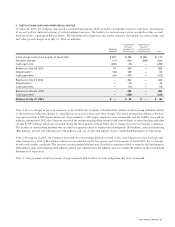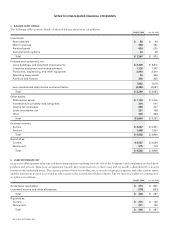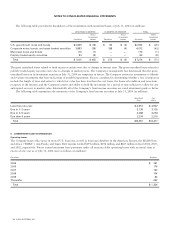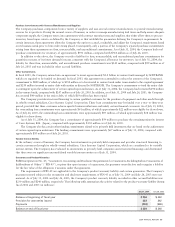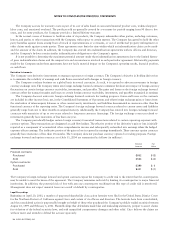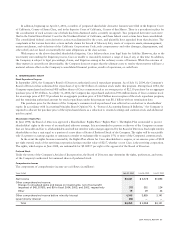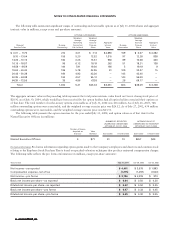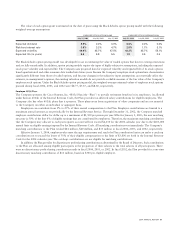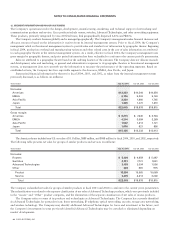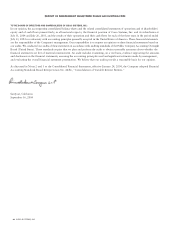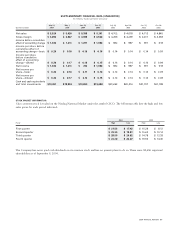Cisco 2004 Annual Report Download - page 58
Download and view the complete annual report
Please find page 58 of the 2004 Cisco annual report below. You can navigate through the pages in the report by either clicking on the pages listed below, or by using the keyword search tool below to find specific information within the annual report.
The value of each option grant is estimated on the date of grant using the Black-Scholes option pricing model with the following
weighted-average assumptions:
EMPLOYEE STOCK OPTION PLANS EMPLOYEE STOCK PURCHASE PLAN
July 31, 2004 July 26, 2003 July 27, 2002 July 31, 2004 July 26, 2003 July 27, 2002
Expected dividend 0.0% 0.0% 0.0% 0.0% 0.0% 0.0%
Risk-free interest rate 3.9% 3.2% 4.7% 2.8% 1.1% 3.1%
Expected volatility 40.0% 45.7% 47.5% 43.2% 45.7% 58.1%
Expected life (in years) 5.6 5.8 5.5 1.9 0.5 0.5
The Black-Scholes option pricing model was developed for use in estimating the value of traded options that have no vesting restrictions
and are fully transferable. In addition, option pricing models require the input of highly subjective assumptions, including the expected
stock price volatility and expected life. The Company uses projected data for expected volatility and expected life of its stock options
based upon historical and other economic data trended into future years. Because the Company’s employee stock options have characteristics
significantly different from those of traded options, and because changes in the subjective input assumptions can materially affect the
estimate, in management’s opinion, the existing valuation models do not provide a reliable measure of the fair value of the Company’s
employee stock options. Under the Black-Scholes option pricing model, the weighted-average estimated values of employee stock options
granted during fiscal 2004, 2003, and 2002 were $8.77, $5.67, and $8.60, respectively.
Employee 401(k) Plans
The Company sponsors the Cisco Systems, Inc. 401(k) Plan (the “Plan”) to provide retirement benefits for its employees. As allowed
under Section 401(k) of the Internal Revenue Code, the Plan provides tax-deferred salary contributions for eligible employees. The
Company also has other 401(k) plans that it sponsors. These plans arose from acquisitions of other companies and are not material
to the Company on either an individual or aggregate basis.
Employees can contribute from 1% to 25% of their annual compensation to the Plan. Employee contributions are limited to a
maximum annual amount as set periodically by the Internal Revenue Service. Through December 31, 2002, the Company matched
employee contributions dollar for dollar up to a maximum of $1,500 per person per year. Effective January 1, 2003, the new matching
structure is 50% of the first 6% of eligible earnings that are contributed by employees. Therefore, the maximum matching contribution
that the Company may allocate to each participant’s account will not exceed $6,150 for the 2004 calendar year due to the $205,000
annual limit on eligible earnings imposed by the Internal Revenue Code. All matching contributions vest immediately. The Company’s
matching contributions to the Plan totaled $81 million, $40 million, and $35 million in fiscal 2004, 2003, and 2002, respectively.
Effective January 1, 2004, employees who meet the age requirements and reach the Plan contribution limits can make a catch-up
contribution not to exceed the lesser of 50% of their eligible compensation or the limit of $3,000 set forth in the Internal Revenue
Code for the 2004 calendar year. The catch-up contributions are not eligible for matching contributions.
In addition, the Plan provides for discretionary profit-sharing contributions as determined by the Board of Directors. Such contributions
to the Plan are allocated among eligible participants in the proportion of their salaries to the total salaries of all participants. There
were no discretionary profit-sharing contributions made in fiscal 2004, 2003, or 2002. In fiscal 2002, the Plan provided for a one-time
discretionary matching contribution of $11 million, based on $500 per eligible employee.
2004 ANNUAL REPORT 61


